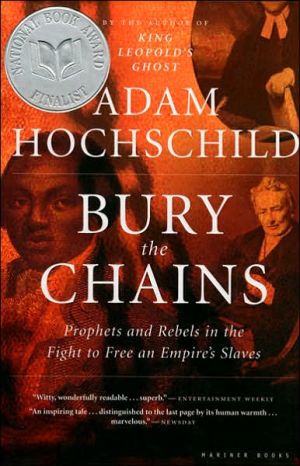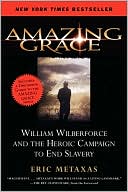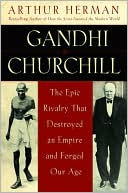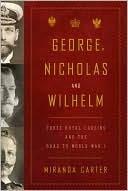Bury the Chains: Prophets and Rebels in the Fight to Free an Empire's Slaves
From the author of the widely acclaimed King Leopold's Ghost comes the taut, gripping account of one of the most brilliantly organized social justice campaigns in history—the fight to free the slaves of the British Empire. In early 1787, twelve men—a printer, a lawyer, a clergyman, and others united by their hatred of slavery—came together in a London printing shop and began the world's first grass-roots movement, battling for the rights of people on another continent. Masterfully stoking...
Search in google:
From the author of the widely acclaimed King Leopold's Ghost comes the taut, gripping account of one of the most brilliantly organized social justice campaigns in history -- the fight to free the slaves of the British Empire. In early 1787, twelve men -- a printer, a lawyer, a clergyman, and others united by their hatred of slavery -- came together in a London printing shop and began the world's first grass-roots movement, battling for the rights of people on another continent. Masterfully stoking public opinion, the movement's leaders pioneered a variety of techniques that have been adopted by citizens' movements ever since, from consumer boycotts to wall posters and lapel buttons to celebrity endorsements. A deft chronicle of this groundbreaking antislavery crusade and its powerful enemies, Bury the Chains gives a little-celebrated human rights watershed its due at last. The New York Times - Marilynne Robinson … Hochschild interprets the success of the British abolitionist movement as a triumph of empathy, a humane response to horrors of which the public only gradually became conscious.
INTRODUCTION: TWELVE MEN IN A PRINTING SHOP\ Strangely, in a city where it seems that on almost every block a famous event or resident is commemorated by a blue and white glazed plaque, none marks this spot. All you can see today, after you leave the Bank station of the London Underground, walk several blocks, and then take a few steps into a courtyard, are a few low, nondescript office buildings, an ancient pub, and, on the site itself, 2 George Yard, a glass and steel high-rise. Nothing remains of the bookstore and printing shop that once stood here, or recalls the spring day more than two hundred years ago when a dozen people—a somber- looking crew, most of them not removing their high-crowned black hats—filed through its door and sat down for a meeting. Cities build monuments to kings, prime ministers, and generals, not to citizens with no official position who once gathered in a printing shop. Yet what these citizens began rippled across the world and we feel its aftereffects still. It is no wonder that they won the admiration of the first and greatest student of what we now call civil society. The result of the series of events begun that afternoon in London, wrote Alexis de Tocqueville, was “absolutely without precedent. . . . If you pore over the histories of all peoples, I doubt that you will find anything more extraordinary.” To understand how momentous was this beginning, we must picture a world in which the vast majority of people are prisoners. Most of them have known no other way of life. They are not free to live or go where they want. They plant, cultivate, and harvest most of the earth’s major crops. They earn no money from their labor. Their work often lasts twelve or fourteen hours a day. Many are subject to cruel whippings or other punishments if they do not work hard enough. They die young. They are not chained or bound most of the time, but they are in bondage, part of a global economy based on forced labor. Such a world would, of course, be unthinkable today.\ But this was the world—our world—just two centuries ago, and to most people then, it was unthinkable that it could ever be otherwise. At the end of the eighteenth century, well over three quarters of all people alive were in bondage of one kind or another, not the captivity of striped prison uniforms, but of various systems of slavery or serfdom. The age was a high point in the trade in which close to eighty thousand chained and shackled Africans were loaded onto slave ships and transported to the New World each year. In parts of the Americas, slaves far outnumbered free persons. The same was true in parts of Africa, and it was from these millions of indigenous slaves that African chiefs and slave dealers drew most of the men and women they sold to Europeans and Arabs sailing their ships along the continent’s coasts. African slaves were spread throughout the Islamic world, and the Ottoman Empire enslaved other peoples as well. In India and other parts of Asia, tens of millions of farmworkers were in outright slavery, and others were peasants in debt bondage that tied them and their labor to a particular landlord as harshly as any slave was bound to a plantation owner in South Carolina or Georgia. Native Americans turned prisoners of war into slaves and sold them, both to neighboring tribes and to the Europeans now pushing their way across the continent. In Russia the majority of the population were serfs, often bought, sold, whipped, or sent to the army at the will of their owners.\ The era was one when, as the historian Seymour Drescher puts it, “freedom, not slavery, was the peculiar institution.” This world of bondage seemed all the more normal then, because anyone looking back in time would have seen little but other slave systems. The ancient Greeks had slaves; the Romans had an estimated two to three million of them in Italy alone; the Incas and Aztecs had slaves; the sacred texts of most major religions took slavery for granted. Slavery had existed before money or written law.\ One measure of how much slavery pervaded the world of the eighteenth century is the traffic on the Atlantic Ocean. We usually think of the Atlantic of this period as being filled with shiploads of hopeful white immigrants. But they were only a minority of those carried to the New World. So rapidly were slaves worked to death, above all on the brutal sugar plantations of the Caribbean, that between 1660 and 1807, ships brought well over three times as many Africans across the ocean to British colonies as they did Europeans. And, of course, it was not just to British territories that slaves were sent. From Senegal to Virginia, Sierra Leone to Charleston, the Niger delta to Cuba, Angola to Braziil, and on dozens upon dozens of crisscrossing paths taken by thousands of vessels, the Atlantic was a conveyor belt to early deathhhhh in the fields of an immense swath of plantations that stretched from Baltimore to Rio de Janeiro and beyond.\ Looking back today, what is even more astonishing than the pervasiveness of slavery in the late 1700s is how swiftly it died. By the end of the following century, slavery was, at least on paper, outlawed almost everywhere. The antislavery movement had achieved its goal in little more than one lifetime.\ This is the story of the first, pioneering wave of that campaign. Every American schoolchild learns how slaves fled Southern plantations, following the North Star on the Underground Railroad. But England is where the story really begins, and for decades it was where American abolitionists looked for inspiration and finally for proof that the colossally difficult task of uprooting slavery could be accomplished. If we were to fix one point when the crusade began, it would be the late afternoon of May 22, 1787, when twelve determined men sat down in the printing shop at 2 George Yard, amid flatbed presses, wooden trays of type, and large sheets of freshly printed book pages, to begin one of the most ambitious and brilliantly organized citizens’ movements of all time.\ A long chain of events, large and small, led to that meeting. Perhaps the most crucial moment came when Thomas Clarkson, a twenty- five-year-old Englishman on his way to London, paused, dismounted from his horse, and sat down at the roadside, lost in thought. Many months later, he would be the principal organizer of the gathering at George Yard. Red-haired, dressed in black, he was the youngest of those who entered the shop that day, perhaps ducking his head slightly as he came through the doorway, for he was a full six inches taller than the average Englishman of his time. In the years to come, his sixteen-hour-a-day campaigning against slavery would take him by horseback on a thirty-five-thousand-mile odyssey, from waterfront pubs to an audience with an emperor, from the decks of navy ships to parliamentary hearing rooms. More than once people would threaten to kill him, and on a Liverpool pier in the midst of a storm, a group of slave ship officers would nearly succeed. Almost forgotten today, he remains one of the towering figures in the history of human rights. Although we will not meet him until Part II of this book, he is its central character.\ There are many others as well, most of whom were not at the meeting that day. John Newton was a slave ship captain who would later write the hymn “Amazing Grace.” Olaudah Equiano was a resourceful slave who earned his freedom, spoke out for others in bondage, and reached tens of thousands of readers with his life story. Granville Sharp, a musician, pamphleteer, and all-round eccentric, rescued a succession of blacks in England from being returned to slavery in the Americas. A London dandy named James Stephen fled to the West Indies to escape an intricately tangled love life, and then was transformed when some slaves he saw in a Barbados courtroom were sentenced to a punishment he found almost unimaginable. A colleague of his became the only abolitionist leader who ever crossed the Atlantic on a slave ship, taking notes in Greek letters to disguise them from the eyes of prying crewmen. Later in time, another key figure was a Quaker widow whose passionate stand against all compromise helped reignite a movement in the doldrums. And one was the leader of history’s largest slave revolt, which defeated the armies of Europe’s two most powerful empires.\ The British abolitionists were shocked by what they came to learn about slavery and the slave trade. They were deeply convinced that they lived in a remarkable time that would see both evils swept from the face of the earth. Like anyone who wages such a fight, they discovered that injustice does not vanish so easily. But their passion and optimism are still contagious and still relevant to our times, when, in so many parts of the world, equal rights for all men and women seem far distant.\ The movement they forged is a landmark for an additional reason. There is always something mysterious about human empathy, and when we feel it and when we don’t. Its sudden upwelling at this particular moment caught everyone by surprise. Slaves and other subjugated people have rebelled throughout history, but the campaign in England was something never seen before: it was the first time a large number of people became outraged, and stayed outraged for many years, over someone else’s rights. And most startling of all, the rights of people of another color, on another continent. No one was more taken aback by this than Stephen Fuller, the London agent for Jamaica’s planters, an absentee plantation owner himself and a central figure in the proslavery lobby. As tens of thousands of protesters signed petitions to Parliament, Fuller was amazed that these were “stating no grievance or injury of any kind or sort, affecting the Petitioners themselves.” His bafflement is understandable. He was seeing something new in history.\ At times, Britons even seemed to be organizing against their own self-interest. From Sheffield, famous for making scissors, scythes, knives, and razors, 769 metalworkers petitioned Parliament in 1789 against the slave trade. “Cutlery wares . . . being sent in considerable quantities to the Coast of Africa . . . as the price of Slaves—your petitioners may be supposed to be prejudiced in their interests if the said trade in Slaves should be abolished. But your petitioners having always understood that the natives of Africa have the greatest aversion to foreign Slavery . . . consider the case of the nations of Africa as their own.” For fifty years, activists in England worked to end slavery in the British Empire. None of them gained a penny by doing so, and their eventual success meant a huge loss to the imperial economy. Scholars estimate that abolishing the slave trade and then slavery cost the British people 1.8 percent of their annual national income over more than half a century, many times the percentage most wealthy countries today give in foreign aid.\ The abolitionists succeeded because they mastered one challenge that still faces anyone who cares about social and economic justice: drawing connections between the near and the distant. We have long lived in a world where everyday objects embody labor in another corner of the earth. Often we do not know where the things we use come from, or the working conditions of those who made them. Were the shoes or shirt you’re wearing made by children in an Indonesian sweatshop? Or by prison labor in China? What pesticides were breathed in by the Latin American laborers who picked the fruit on your table? And do you even know in what country the innards of your computer were assembled? The eighteenth century had its own booming version of globalization, and at its core was the Atlantic trade in slaves and in the goods they produced. But in England itself there were no caravans of chained captives, no whip-wielding overseers on horseback stalking the rows of sugar cane. The abolitionists’ first job was to make Britons understand what lay behind the sugar they ate, the tobacco they smoked, the coffee they drank.\ One thing more makes these men and women from the age of wigs, swords, and stagecoaches seem surprisingly contemporary. This small group of people not only helped to end one of the worst of human injustices in the most powerful empire of its time; they also forged virtually every important tool used by citizens’ movements in democratic countries today.\ Think of what you’re likely to find in your mailbox—or electronic mailbox—over a month or two. An invitation to join the local chapter of a national environmental group. If you say yes, a logo to put on your car bumper. A flier asking you to boycott California grapes or Guatemalan coffee. A poster to put in your window promoting this campaign. A notice that a prominent social activist will be reading from her new book at your local bookstore. A plea that you write your representative in Congress or Parliament, to vote for that Guatemalan coffee boycott bill. A “report card” on how your legislators have voted on these and similar issues. A newsletter from the group organizing support for the grape pickers or the coffee workers.\ Each of these tools, from the poster to the political book tour, from the consumer boycott to investigative reporting designed to stir people to action, is part of what we take for granted in a democracy. Two and a half centuries ago, few people assumed this. When we wield any of these tools today, we are using techniques devised or perfected by the campaign that held its first meeting at 2 George Yard in 1787. From their successful crusade we still have much to learn.\ If, early that year, you had stood on a London street corner and insisted that slavery was morally wrong and should be stopped, nine out of ten listeners would have laughed you off as a crackpot. The tenth might have agreed with you in principle, but assured you that ending slavery was wildly impractical: the British Empire’s economy would collapse. The parliamentarian Edmund Burke, for example, opposed slavery but thought that the prospect of ending even just the Atlantic slave trade was “chimerical.” Within a few short years, however, the issue of slavery had moved to center stage in British political life.\ There was an abolition committee in every major city or town in touch with a central committee in London. More than 300,000 Britons were refusing to eat slave-grown sugar. Parliament was flooded with far more signatures on abolition petitions than it had ever received on any other subject. And in 1792, the House of Commons passed the first law banning the slave trade. For reasons we will see, a ban did not take effect for some years to come, and British slaves were not finally freed until long after that. But there was no mistaking something crucial: in an astonishingly short period of time, public opinion in Europe’s most powerful nation had undergone a sea change. From this unexpected transformation there would be no going back.\ “Never doubt,” said Margaret Mead, “that a small group of thoughtful, committed citizens can change the world. Indeed, it is the only thing that ever has.” This book is about one such group. Their story is not a simple one, but a ragged and untidy epic that did not unfold in the orderly way they hoped for. It would sprawl across decades and continents, encompassing not just the long Atlantic traffic in slaves and the British slave colonies of the Caribbean, but also threads that stretched to unexpected places as far off as New York, Nova Scotia, and an improbable Utopian colony on the coast of Africa. It would be filled with dashed hopes and wrong turnings. It would become interwoven with great historical currents which, on that afternoon in the George Yard printing shop in 1787, no one foresaw: above all the dreams of equality unleashed by the French Revolution, and a series of ever-larger slave revolts that shook the British Empire and made clear that if the slaves were not emancipated they might well free themselves. The stage on which British slavery lived and at last died was a vast one. We must begin by visiting—through the eyes of future players in the drama of abolition—several corners of that world of bondage which, to a citizen of the eighteenth century, looked as if it would endure for all time.\ Copyright © 2005 by Adam Hochschild. Reprinted by permission of Houghton Mifflin Company.
Introduction : twelve men in a printing shop11Many golden dreams112Atlantic wanderer303Intoxicated with liberty414King sugar545A tale of two ships696A moral steam engine857The first emancipation988"I questioned whether I should even get out of it alive"1069Am I not a man and a brother?12210A place beyond the seas14311"Ramsay is dead - I have killed him"15212An eighteenth-century book tour16713The blood-sweetened beverage18114Promised land19915The sweets of liberty21316High noon in parliament22617Bleak decade24118At the foot of Vesuvius25619Redcoats' graveyard28020"These gilded Africans"28821A side wind29922Am I not a woman and a sister?30923"Come, shout o'er the grave"333Epilogue : "to feel a just indignation"355AppWhere was Equiano born?369
\ The New YorkerHochschild’s history of British abolitionism notes that ending slavery would have seemed as unlikely in eighteenth-century England as banning automobiles does today. Despite the “latent feeling” among intellectuals that slavery was barbarous, Caribbean sugar plantations were seen as a necessary part of the economy. Prefiguring many social movements to come, the anti-slavery crusade was driven by the partnership between a committed activist, Thomas Clarkson, and a connected politician, William Wilberforce. It was Clarkson and his Quaker associates who pioneered the use of petitions, eyewitness accounts, and even an early, innocent form of direct-mail solicitation. Hochschild argues that the violent techniques of naval press gangs primed England’s populace to consider the plight of the slaves. His capacious narrative is both disturbing and fascinating, and not without its ironies: when Parliament finally did abolish slavery, in 1833, plantation owners were generously compensated for their loss of “property.”\ \ \ \ \ Steven MufsonAdam Hochschild's wonderful, vivid new Bury the Chains argues, in part, that the British abolition movement of the late 1700s pioneered the strategies that every activist group now takes for granted: direct mailings, legal test cases, campaign pins, grassroots lobbying. … Fascinating as this is, what makes Hochschild's book so readable is the rich cast of characters who created the movement, and the appalling nature of slavery itself. This isn't just any social movement, and the reader can't help but share the mingled sense of outrage and disbelief that the abolitionists themselves must have felt as they witnessed or heard about the incredible inhumanity of this practice.\ — The Washington Post\ \ \ Marilynne Robinson… Hochschild interprets the success of the British abolitionist movement as a triumph of empathy, a humane response to horrors of which the public only gradually became conscious.\ — The New York Times\ \ \ \ \ Library JournalHochschild (King Leopold's Ghost) enlightens general readers on the main men (and at least one woman), methods, and motivations behind the cause officially launched in 1787 that culminated by 1838 in the formal end of forced labor in the British Empire. Hochschild successfully anchors his work of synthesis around the personalities of Olaudah Equiano, an ex-slave author of a famous memoir; John Newton, the former slave ship captain who later authored "Amazing Grace"; Thomas Clarkson, an investigative journalist; William Wilberforce, the essential inside agitator and conscience-driven evangelical Member of Parliament; and Elizabeth Heyrick, a radical Quaker essayist. The author's intent is to show how this drive in Britain both transformed a world in which it was the norm for "the vast majority of people [to be] prisoners" and set a precedent for using committees, petitions, lapel buttons, and other forms of agitation to mobilize public opinion. In gruesome detail, the reader learns that profits from the slave trade ironically provided the funds for university libraries, hospitals, poorhouses, and elegant residences. Although scholars of this period should already be well acquainted with these empathetic reform figures, the nonprofessional history buff will benefit from this concise and readable summary of their accomplishments. Recommended for general history collections. [See Prepub Alert, LJ 9/15/04.]-Frederick J. Augustyn Jr., Library of Congress Copyright 2004 Reed Business Information.\ \ \ \ \ Kirkus ReviewsA late-18th-century band of abolitionists in England begins the movement that will eventually free nearly one million slaves across the British Empire-and show the world that idealism and a passion for human rights can fill the sails of the ship of state. Hochschild (King Leopold's Ghost: A Story of Greed, Terror, and Heroism in Colonial Africa, 1998, etc.) has crafted a powerfully inspiring tale of how a few-a persistent few-can eventually convince the many to question their most fundamental beliefs. In May 1787, a dozen men, mostly Quakers, met in London to discuss ways they might bring about the end of England's involvement in the slave trade. Among them was Thomas Clarkson (the only one to live long enough to see the deferred dream realized), an indefatigable, creative advocate for human rights. The author says Clarkson has been neglected by history, but he emerges here as a moral warrior of the highest rank. Hochschild demonstrates persuasively that Clarkson and his followers (who eventually numbered in the hundreds of thousands) created and employed techniques for public persuasion still common today: boycotting, petitioning, direct-mail fund-raising. These men, though impelled by moral motives, argued the economic case for abolition, as well, this back in a time when slavery was a pervasive feature of life on every continent, and people questioned the practice no more than we question our use of automobiles. One of Hochschild's great strengths, indeed, is his ability to get inside the 18th-century mind and show how our ancestors' assumptions parallel our own. Personal histories of the principals (William Wilberforce, James Stephen, John Newton) have their place, and Hochschildexplains how geopolitical forces, especially England's bitter rivalry with France, affected the movement. Some of the details about conditions on slave ships, including the brutalities of repression and retribution, are painful to read. A chronicle of a rare and radiant victory by our better angels. (16 pp. b&w photos, not seen)Author tour. Agent: Georges Borchardt\ \








